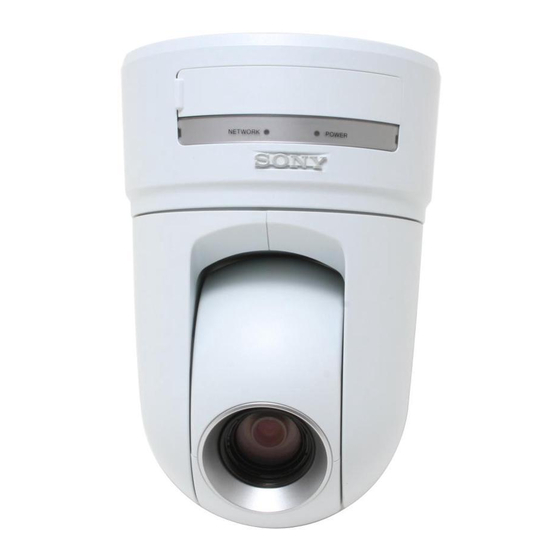Sony SNC-RZ25N - Network Camera Podręcznik referencyjny - Strona 2
Przeglądaj online lub pobierz pdf Podręcznik referencyjny dla Aparat cyfrowy Sony SNC-RZ25N - Network Camera. Sony SNC-RZ25N - Network Camera 2 stron. Ntsc/pal
Również dla Sony SNC-RZ25N - Network Camera: Katalog (44 strony), Skrócona instrukcja obsługi (20 strony), Broszura i specyfikacje (6 strony), Uwaga dotycząca integracji (4 strony)

Glossary
IP66
The "IP" of IP66 stands for Ingress Protection, and its two-digit number shows
the durability rating of equipment for outdoor use. The first digit of IP66 relates
to the ingress protection against dust, and "6" means "dust tight". The second
digit of IP66 relates to the ingress protection against water, and "6" means
protected against "heavy jet sprays," such as conditions that can be
encountered in hurricanes..
Day/Night
A day/night camera has two modes of operation: a day mode and a night
mode. The camera switches from day mode (Color) to night mode (B/W) by
replacing its infrared-cut filter with a clear filter. In night mode, the camera
becomes sensitive to near-IR light and is capable of reproducing images even
when the scene is not visible to the naked eye.
Wide-D
State-of-the-art technologies to expand the video dynamic range of the camera
to improve the visibility of images even in extremely high-contrast
environments. Wide-D is a powerful feature to compensate for scenes with
extremely poor contrast.
DynaView Technology
DynaView™ is one of Sony's Wide-D technologies.
With DynaView technology, the camera captures two images for each frame
using an electronic shutter – the first image is taken with a 'standard' exposure
time and the second image is taken with a very short exposure time. The dark
areas in the scene are clearly reproduced in the first image and the bright
areas are reproduced without being 'washed out' in the second image. The two
images are then combined into one by using an advanced DSP LSI, to
reproduce high-contrast images.
© 2009 Sony Electronics Inc. All rights reserved. Reproduction in whole or in part without written permission is prohibited.
Features and specifications are subject to change without notice. All non-metric weights and measurements are approximate.
Sony, the Sony logo, ONVIF, DynaView, and DEPA are trademarks of Sony. All other trademarks are the property of their respective owners.
click:
sony.com/security
sony.com/sonysports
Visibility Enhancer (VE)
VE is one of Sony's new technologies that optimizes contrast and makes a
scene more visible. It is ideal for scenes where objects are hard to recognize
due to severe backlight or shadows. VE optimizes the brightness and color
reproduction of an image dynamically on a pixel-by-pixel basis while
continuously adapting to the scene. Technically, VE stretches the contrast in
both the backlit portions and the shadows within the given dynamic range,
which is different from Wide-D. VE also contributes to the high sensitivity of the
camera. By combining VE with XDNR, the camera can reproduce clear and
bright images in very low-light conditions, while keeping noise at a minimal level.
XDNR
(eXcellent Dynamic Noise Reduction)
XDNR is Sony's latest technology for noise reduction in IP security cameras.
XDNR utilizes 2D and 3D noise reduction methods adaptively to scenes. Under
low-light conditions, XDNR provides clear images for both moving objects and
still portions of the image, using 2DNR and 3DNR, respectively. This method
provides clear images while minimizing motion blur which is a challenge in
any outdoor surveillance monitoring applications, such as in parking lots.
DEPA System
With a Sony DEPA system, DEPA-enabled cameras send not only video images
but also related metadata, including object data (size and position) to the
DEPA-enabled recorder. Since part of the image processing is done on the
camera side, the load to the recorder can be reduced enabling camera
expansion. Conventional video analytic systems, on the other hand, process
images solely on the recorder side often causing CPU overload.
DEPA Advanced
DEPA™ Advanced is an enhanced DEPA technology. Unlike DEPA, a camera
incorporating DEPA Advanced completes the entire DEPA analysis such as
intrusion detection with a virtual borderline on the camera side, and sends only
an alarm to the recorder. Enhancements also include a tamper alarm, shadow
cancellation, a beam intrusion detector, and audio analysis. Since the analytic
processing is completed in the camera, end users can benefit from
DEPA Advanced because it can be easily integrated with a variety of recorders
and/or video management solutions.
ONVIF Software
ONVIF™ software defines a common protocol for the exchange of information
between different network video devices regardless of manufacturer, and
achieves greater interoperability in multi-vendor network video systems.
PoE
(Power-over-Ethernet, IEEE 802.3af)
PoE enables networked devices to receive power up to 13.95W from
PoE-enabled equipment through the same Ethernet cable that transports data.
It provides substantial savings in installation costs and can simplify the
installation process.
hPoE
(High PoE, IEEE 802.3at )
hPoE enables networked devices to receive power up to 25W from
hPoE-enabled equipment through the same Ethernet cable that transports
data. hPoE is useful especially for PTZ/Rapid Dome cameras that require motor
control.
S-IP2049
Printed in USA (9/09)
2009 Fall
MK10619V1
